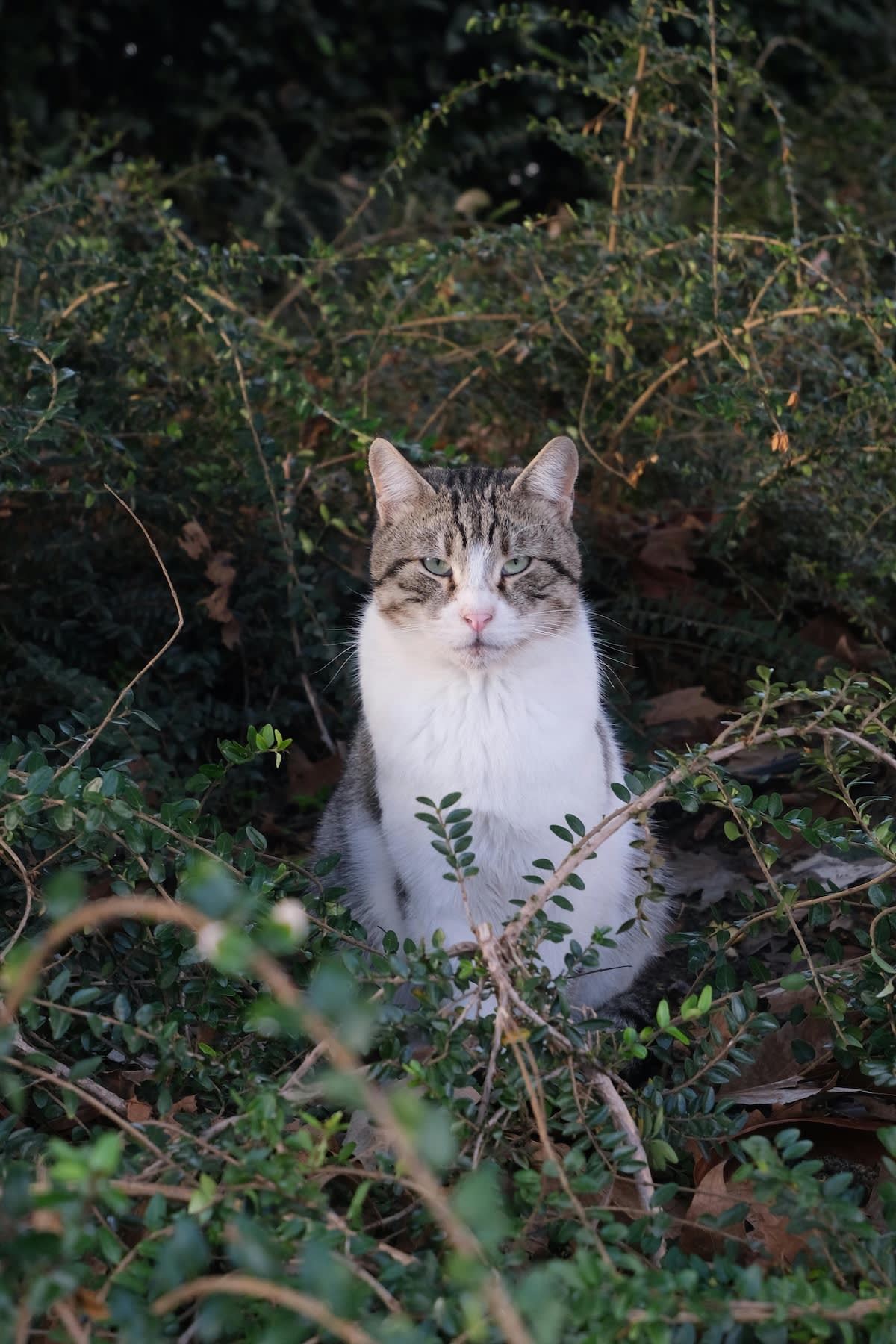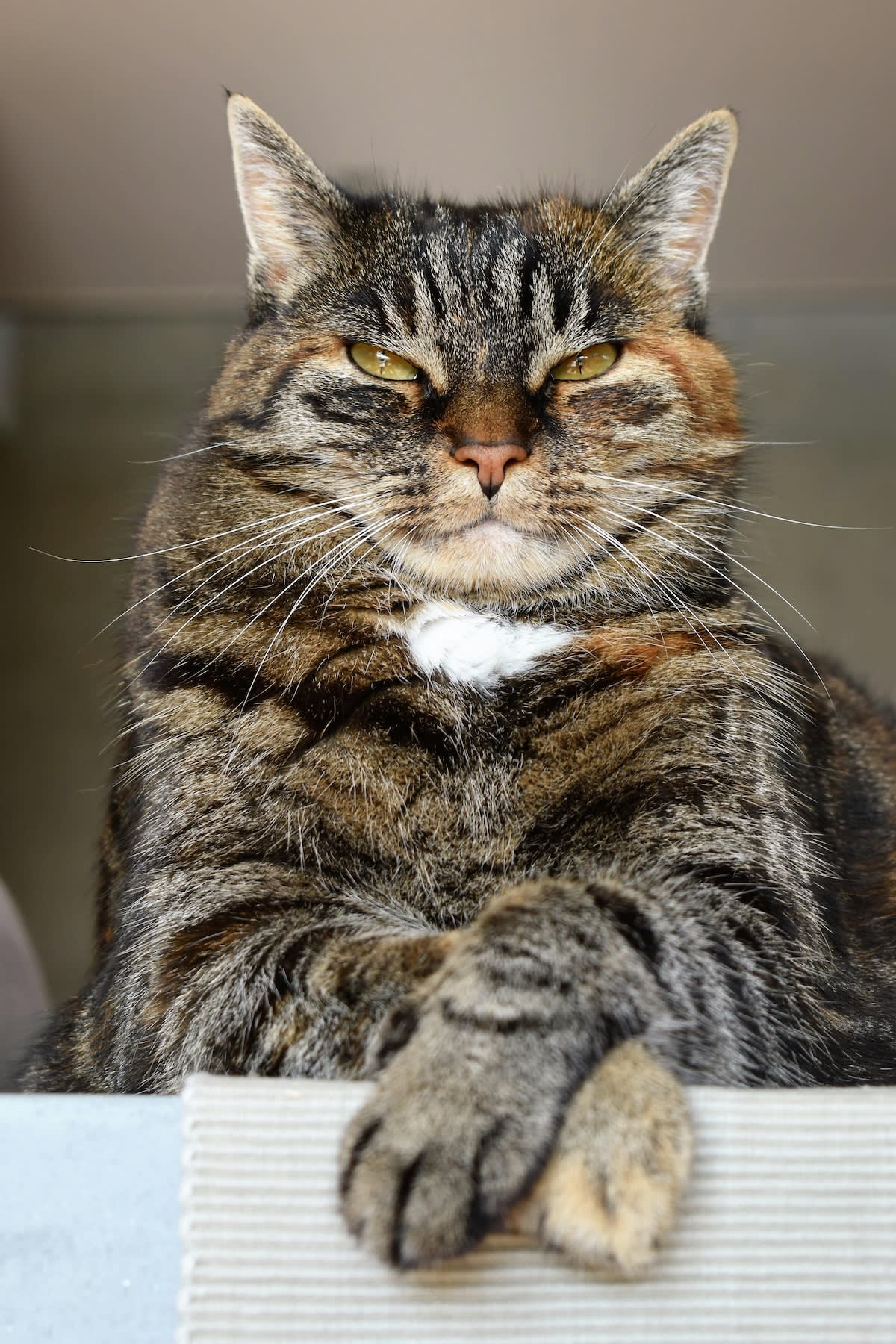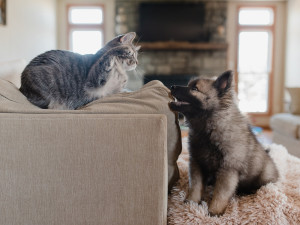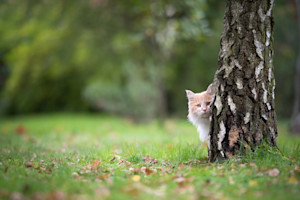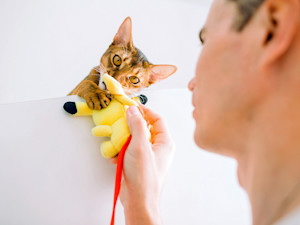Unexpected Signs Your Cat Is Smarter Than the Rest
What science tells us about feline intelligence
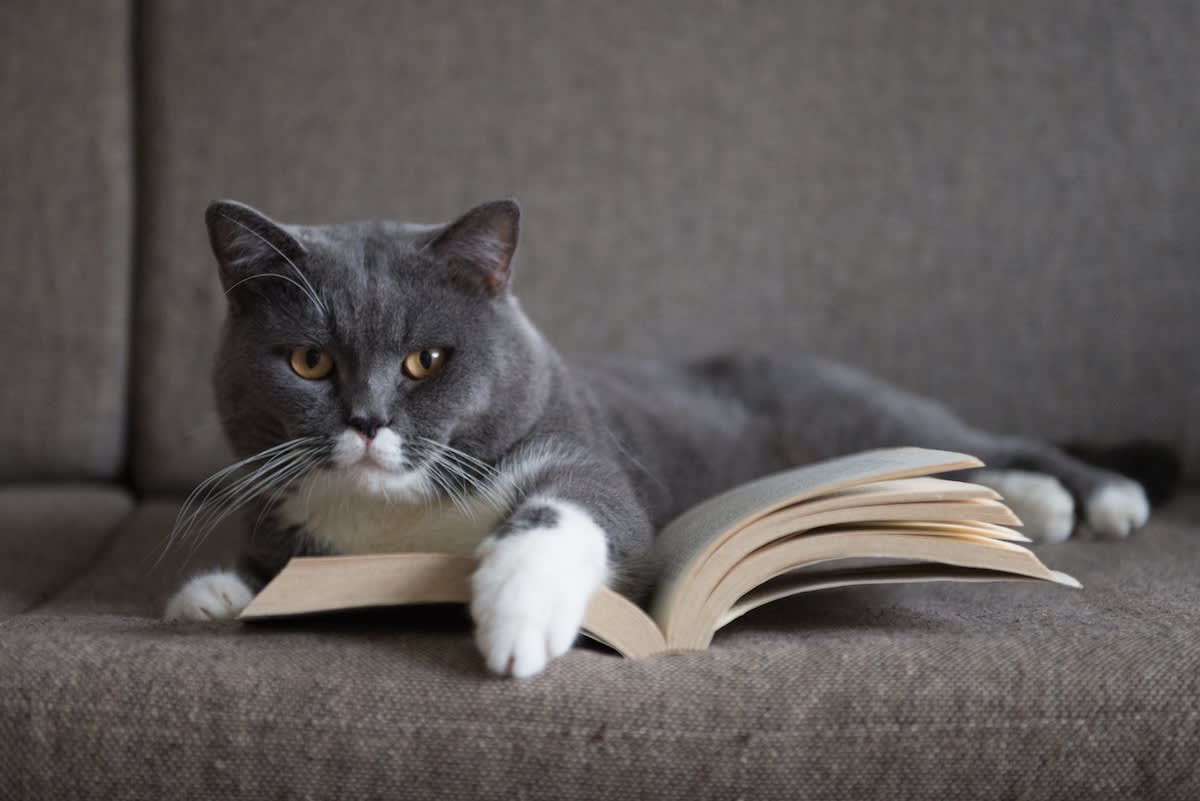
Share Article
In this article:
What is cat intelligence? Signs of cat intelligence Smart cat breeds? Test your cat’s intelligence Nurturing smart cats When cats are too clever
If you’re like me, you might have looked at your cat with amazement more than once and thought, “My cat is definitely a genius. How did he get to be so smart?” Or maybe you’re in the other camp where you see your cat chasing their tail, attempting a backflip off the sofa or knocking a full glass of water off the table, and you think, “Right, definitely not Oxbridge material then.”
Either way, feline intelligence isn’t about Sudoku-level problem-solving, it’s actually about how effectively they navigate a world built for humans – opening doors, learning routines, decoding our moods and negotiating snacks with unnerving precision.
Scientists increasingly agree that cats process information in surprisingly sophisticated ways, from remembering specific past events to reading human cues such as pointingopens in new tab and voice identityopens in new tab. At the same time, research also shows their social style is different from dogs: cats can bond and communicateopens in new tab, but strictly on their own terms (classic cats), which can make their smarts easy to miss.
Read on to find out what cat intelligence actually means, how to spot it and what you can do to nurture your little Einstein.
What do we mean by cat intelligence?
When scientists talk about cat intelligence, they’re describing how effectively cats learn, remember and adapt – not how well they obey cues like ‘sit’ or ‘paw’ (we’re looking at you, dogs). Intelligence in cats covers several mental abilities: problem-solving, memory, flexibility and social awareness. It’s what allows them to navigate our homes as confidently as their wild ancestors once navigated forests – interpreting humans, learning routines and making decisions that get them what they want.
A cat’s IQ has been compared to that of a human toddler. Studiesopens in new tab have found that cats have various smarts, such as object permanence, working memory, sensitivity to human cues and more. In addition, cats can recognise different people’s voices, and can tell the difference between various quantities as well as short and long periods of time.
They even adjust their vocal cues to influence us. (Yes, that “feed me” meow may be more strategic/manipulative than genuinely desperate.) For instance, they’re known to use an infant-like ‘cry’opens in new tab embedded in a purr to tap into our caregiving instincts.
Rather than testing for abstract logic, scientists assess how cats use learning and memory to adapt to changing environments and relationships. In essence, feline intelligence is measured not by obedience but by ingenuity – and by how skilfully cats turn curiosity into strategy.
Signs your cat may be smart
It’s easy to dismiss cat antics as mere mischief, but many of our feline overlords’ everyday behaviours reveal real intelligence at work. Cats that learn routines, manipulate environments and communicate clearly are using the same mental skills researchers study in labs: memory, problem-solving and social cognition.
Quickly learning routines
If your cat waits by the door just before their favourite human comes home or materialises in the kitchen the second the fridge opens, that’s not magic. Studies suggest cats use temporal learningopens in new tab – recognising patterns in time and associating them with predictable outcomes. In one studyopens in new tab, cats remembered the ‘what’ and ‘where’ of past meals for up to 15 minutes. In daily life, this helps them recognise patterns in time and associate them with outcomes (like you closing your laptop and finishing work for the day as a sign that it’s dinner time).
Solving puzzles or opening cupboards
Cats that figure out how to open cupboard doors or manipulate puzzle feeders are displaying goal-directed problem-solving. Research showsopens in new tab that domestic cats use trial-and-error learning and rapidly abandon unproductive strategies when facing obstacles.
Strong communication skills with humans
From a well-timed headbutt to a calculated meow, clever cats customise their communication to what humans respond to. Not only can they distinguish their humans’ voices but cats also alter the pitch and urgency of vocalisations to manipulate human attention. Some cats even modify gestures, such as paw taps or eye contact, depending on how effectively they elicit the desired response, a hallmark of social learningopens in new tab. All of which explains why my cat knows that if he makes direct eye contact with me while repeatedly flapping the leaf of a plant, it will eventually annoy me to the point that I will get up and pay attention to him.
(Quick tally: yes my cat runs downstairs when he hears the fridge opening; yes he solves puzzle feeders – apparently rated ‘medium difficulty’ for dogs #humblebrag; and yes he has me totally wrapped around his little paw. So maybe my assessment of his intelligence was correct after all.)
Are some cat breeds more intelligent than others?
It’s tempting to believe that feline intelligence is built into a pedigree, but the science tells a more complex story. Some breeds do show consistent behavioural tendencies – for example, Abyssinians are known for constant curiosity, Bengals for energetic problem-solving, and Siamese cats for their vocal, social nature. These patterns reflect underlying genetic influences on personality and motivation, which can make certain cats seem more inquisitive or quick to learn.
However, research suggests that while genetics play a role, they don’t define the full picture. A large studyopens in new tab from the University of Helsinki examined behaviour in more than 5,726 cats across 19 breeds and found that around 40–50 percent of variation in behavioural traits is heritable – meaning roughly half is shaped by environment and experience instead. Traits such as activity level, sociability and boldness varied among breeds, but there was considerable overlap, showing that intelligence-related behaviour can’t be cleanly predicted by breed alone.
Which breeds are known as ‘clever’?
Certain breeds are frequently praised for their sharp minds and eagerness to engage with humans. Oriental Shorthairs are known for their curiosity and quick responsiveness to training, often learning tricks or cues with ease. Burmese cats combine sociability with problem-solving persistence, readily exploring new toys or figuring out how to open cupboards. Maine Coons, meanwhile, tend to excel in spatial reasoning – pet parents often describe them as ‘dog-like’ in their ability to follow routines and retrieve toys.
Behavioural studiesopens in new tab show that these breeds often score higher in activity, curiosity and sociability – traits linked to what humans perceive as intelligence. Yet experts say that motivation (much like what drives most of our cats’ behaviour), not IQ, often explains the difference. Active cats engage more readily with problem-solving tasks, while quieter breeds may be just as cognitively capable but less driven to participate.
Why environment and enrichment matter more than breed
Feline cognition and welfare research shows that stimulation, play and social contact strongly shape how cats learn and adapt, often overshadowing the influence of breed. For example, higher environmental enrichment is linked to reduced stressopens in new tab (lower cortisol levels) and greater behavioural engagement. And home-based studiesopens in new tab show that cats prefer and make use of enriched resources – toys, climbing structures, interactive elements – suggesting that opportunity and environment unlock their potential.
Easy ways to test your cat’s intelligence at home
Testing your cat’s intelligence doesn’t require a lab coat – just curiosity and a few household props. The goal isn’t to ‘score’ your cat but to see how they think, adapt and problem-solve. Every cat learns differently, so watch for persistence, creativity and confidence as much as success.
Puzzle feeders and toys
Interactive feeders and puzzle toys are one of the best ways to gauge (and build) feline problem-solving skills. Research shows that cats using puzzle feedersopens in new tab demonstrate reduced boredom, lower stress and improved exploratory behaviour. When faced with a simple food puzzle, intelligent cats typically vary their strategy – pawing, flipping or repositioning objects – rather than giving up.
Try a beginner puzzle like a ball feeder or treat maze and observe how long it takes your cat to work it out. Cats that persist, adapt or return to a problem after pausing are demonstrating flexible thinking and memory – two hallmarks of feline intelligence.
Hiding treats to test problem-solving
Hide treats under cups or in different parts of a room to test spatial memory and strategy use. Cats capable of remembering locations over several minutes – or tracking your hand movements – are showing evidence of episodic-like memory.
Observing how fast they adapt to new situations
Intelligent cats tend to adjust quickly to environmental changes, like new furniture, visitors or altered feeding routines. Behavioural scientists describe this as “cognitive flexibilityopens in new tab” – the ability to update old information and learn new rules.
When introducing a new toy or moving furniture, notice whether your cat cautiously investigates or avoids change altogether. Cats that engage, explore and learn through trial and error are displaying adaptive intelligence. Encouraging safe exploration with familiar scents and gradual introductions helps even cautious cats strengthen these learning skills over time.
How to nurture a smart cat
Just like people, cats need mental stimulation to stay sharp and well-balanced. A ‘smart’ cat isn’t only one that can open doors – it’s one that’s curious, confident and emotionally secure. Enrichment builds intelligence by turning everyday routines into chances for play and problem-solving. Interactive games, from feather teasers to puzzle feeders, boost focus and reduce stress. Training sessions, including clicker training, also stimulate feline brains.
For the cats living mostly indoors, environmental enrichment is vital for well-being and cognitive health. Without it, boredom and frustration can lead to over-grooming or night-time restlessness. Create climbing spots, rotate toys and add window perches or scent trails with catnip or hidden treats. Cats given varied, stimulating environments usually display more positive behaviour and stronger learning performance. Enrichment doesn’t have to be fancy – it just needs to spark curiosity. A thinking cat is a happy cat.
When ‘clever’ might be a problem
A bright cat can be both a blessing and a handful. Highly intelligent cats often crave extra stimulation, and when they don’t get it, they invent their own entertainment – whether that’s unrolling toilet paper or ambushing ankles at 3am. Behaviourists emphasise that these aren’t acts of defiance but signs of boredom or unmet cognitive needs. Cats with strong problem-solving instincts can develop stress behaviours when they lack outlets for their curiosity, including repetitive pacing, over-grooming and destructive scratching.
If your cat seems restless after playtime, meows insistently at odd hours or launches into spontaneous ‘chaos missions’, it may be a signal that they need more mental work. Short, structured play sessions twice a day, small environmental changes to keep things interesting, and rotating puzzle feeders, foraging toys and climbing opportunities can redirect excess energy into satisfying problem-solving. Think of it as mental cross-training: when your cat’s brain stays busy, mischief turns into curiosity well spent.
Resources
Colavita, F. “Temporal Pattern Discrimination in the Cat.opens in new tab” Physiology & Behavior, vol. 18, no. 3, 1977, pp. 513-21.
de Mouzon, C., and G. Leboucher. “Multimodal Communication in the Human-Cat Relationship: A Pilot Study.opens in new tab” Animals: An Open Access Journal from MDPI, vol. 13, no. 9, 2023, p. 1528.
Ellis, S. L. “Environmental Enrichment: Practical Strategies for Improving Feline Welfare.opens in new tab” Journal of Feline Medicine and Surgery, vol. 11, no. 11, 2009, pp. 901-12.
Foerder, P., and M. C. Howard. “Effects of Socialization on Problem Solving in Domestic Cats.opens in new tab” Animals, vol. 14, no. 17, 2024, pp. 2604-04.
Lewis, A., and D. Berntsen. “Pet Memoirs: The Characteristics of Event Memories in Cats and Dogs, as Reported by Their Owners.opens in new tab” Applied Animal Behaviour Science, 2019, p. 104885.
Mäses, M., and C. A. F. Wascher. “Assessing Cats' (Felis catus) Sensitivity to Human Pointing Gestures.opens in new tab” Journal of Comparative Psychology, vol. 137, no. 1, 2023, pp. 38-44.
McComb, K. “The Cry Embedded Within the Purr.opens in new tab” Current Biology, vol. 19, no. 13, 2009, pp. R507-08.
Rehnberg, L. K., et al. “The Effects of Social Interaction and Environmental Enrichment on the Space Use, Behaviour and Stress of Owned Housecats Facing a Novel Environment.opens in new tab” Applied Animal Behaviour Science, vol. 169, 2015, pp. 51-61.
Saito, A., et al. “Domestic Cats (Felis catus) Discriminate Their Names from Other Words.opens in new tab” Scientific Reports, vol. 9, no. 1, 2019.
Salonen, M., et al. “Breed Differences of Heritable Behaviour Traits in Cats.opens in new tab” Scientific Reports, vol. 9, no. 1, 2019.
Shevchyk, L., et al. “Behavioural Adaptation of Domestic Animals on the Example of Different Breeds of Domestic Cat (Felis silvestris catus L., 1758).opens in new tab” Scientific Horizons, vol. 26, no. 2, 2023.
Vitale, K. R., and M. A. R. Udell. “The Quality of Being Sociable: The Influence of Human Attentional State, Population, and Human Familiarity on Domestic Cat Sociability.opens in new tab” Behavioural Processes, vol. 158, 2019, pp. 11-17.
Wojtaś, Justyna, et al. “The Impact of Environmental Enrichment on the Cortisol Level of Shelter Cats.opens in new tab” Animals, vol. 14, no. 9, 2024, pp. 1392-92.
Ro Elfberg
Ro is Kinship UK’s Senior Editor. She has previously written and copy-edited for British Vogue, Glamour and DICE. When she’s not being manipulated into dishing out Dreamies to Kobe the cat, she spends her free time trying to convince her snake, Butters, to wear a tiny hat.
Related articles
Cats vs Dogs: Exploring Feline Intelligence and Canine IQ
A common (if not silly) question with a complicated answer
![A German shepherd and cat play affectionately in a bed.]()
The Real Differences Between Cats and Dogs
There’s no winning this argument, but here’s what you should know about parenting each perfect pet
![Woman and her Dalmatian puppy look in the mirror at their reflections.]()
Do Dogs and Cats Recognise Themselves in the Mirror?
Mirror, mirror on the wall, who’s the cutest of them all?
![a picture of a fluffy ginger cat peeking out from behind a tree timidly]()
Everything You Knew About Cat Curiosity Is Wrong
Everything you thought you knew about our feline friends is wrong
![cat playing with pikachu toy]()
Happy Cat, Happy Life: 5 Enrichment Tips to Keep Your Kitty Content
What is enrichment and why is it so important to keep your kitty happy?

